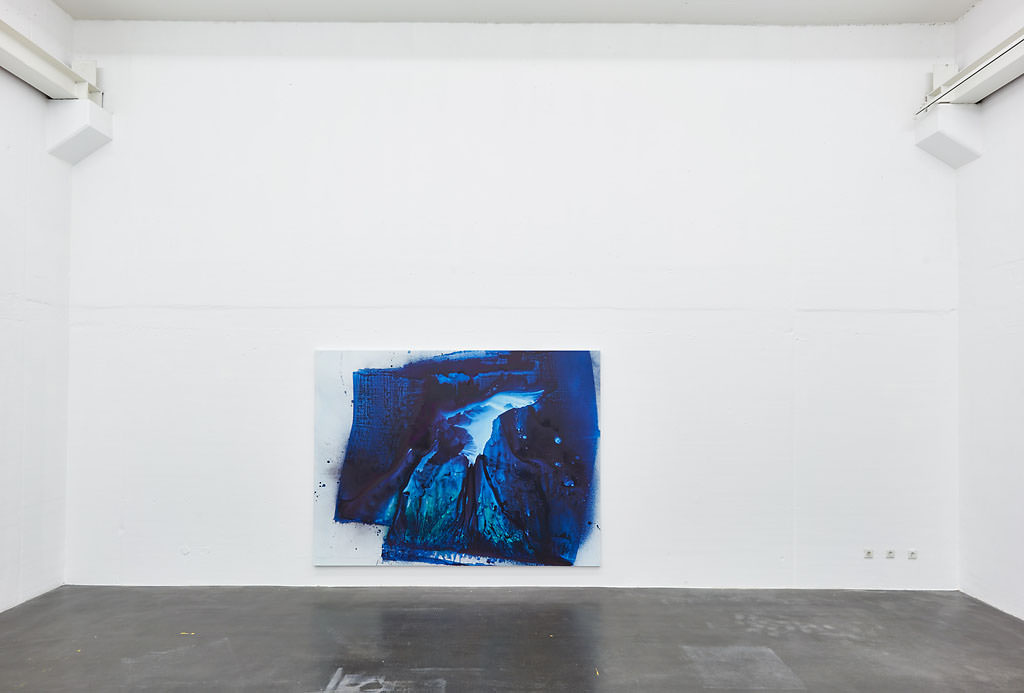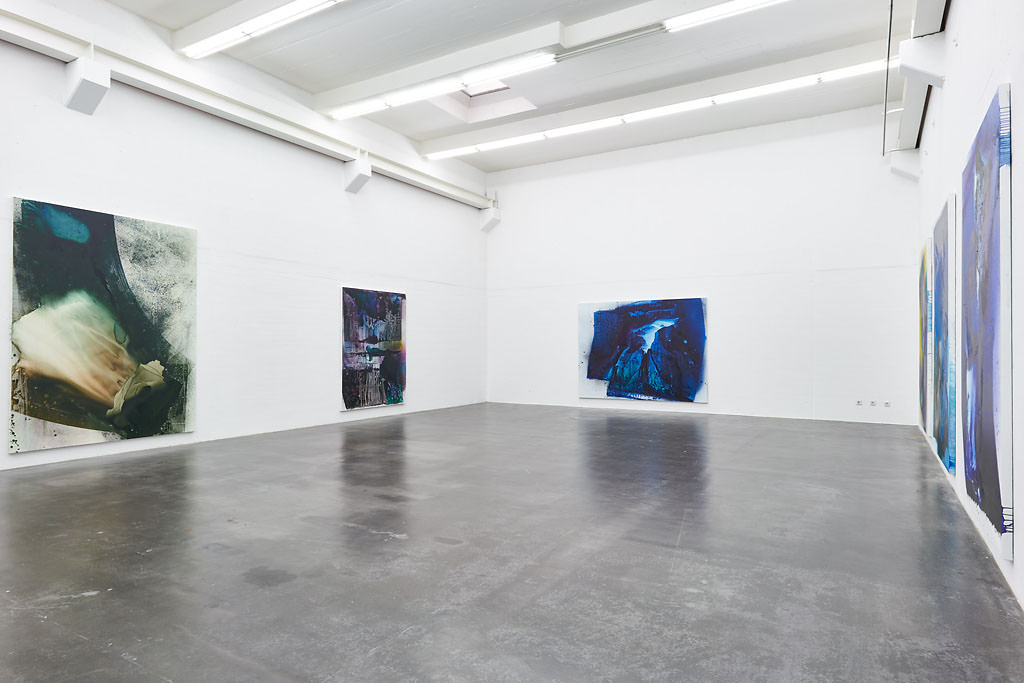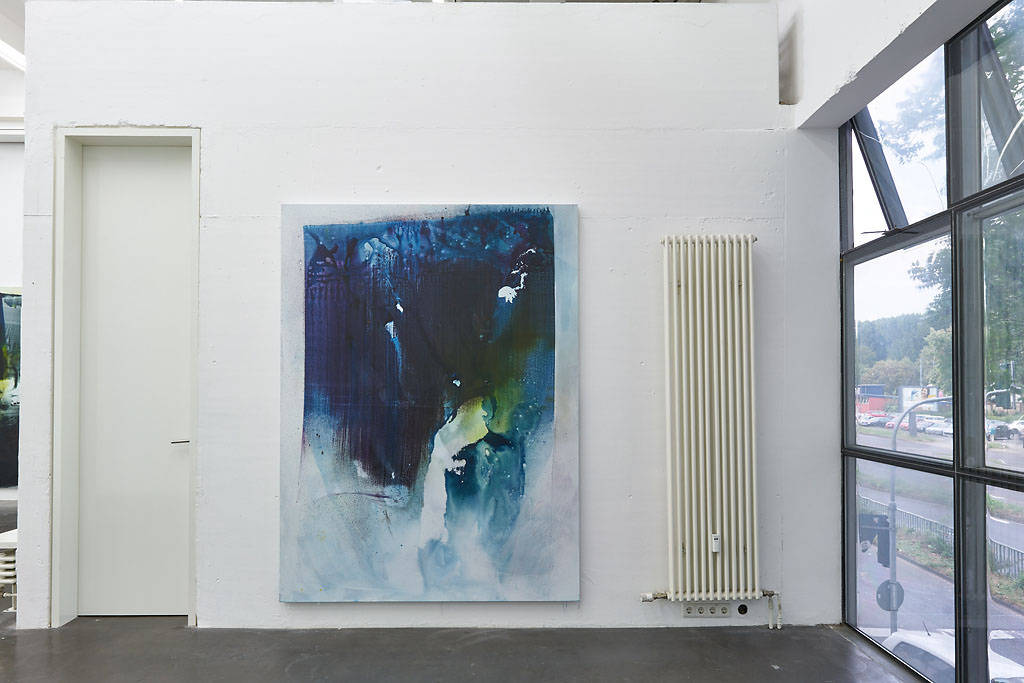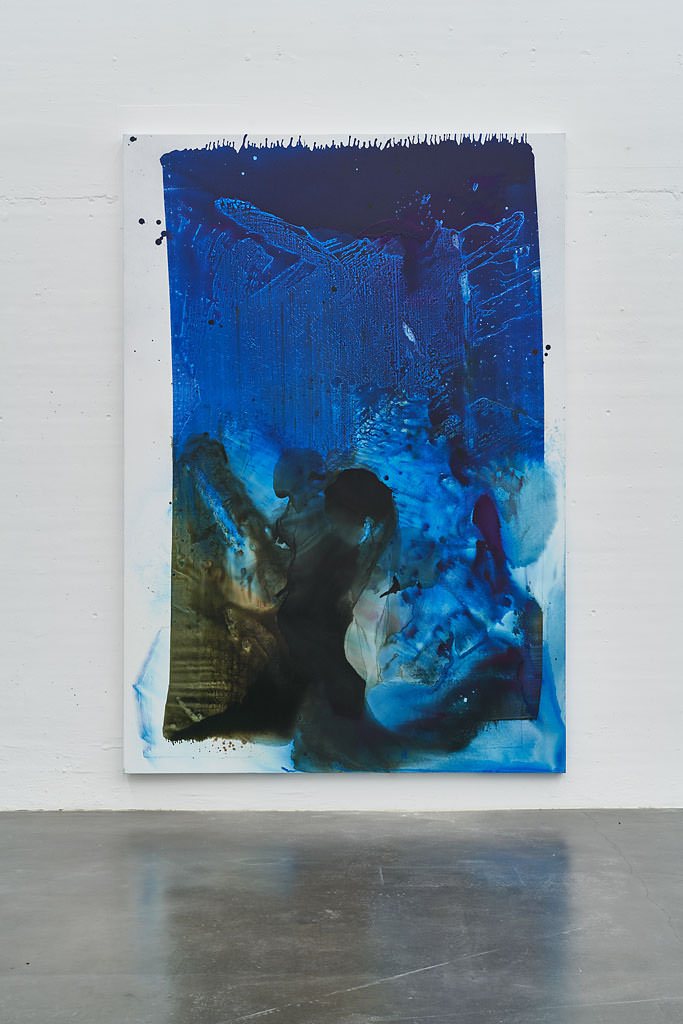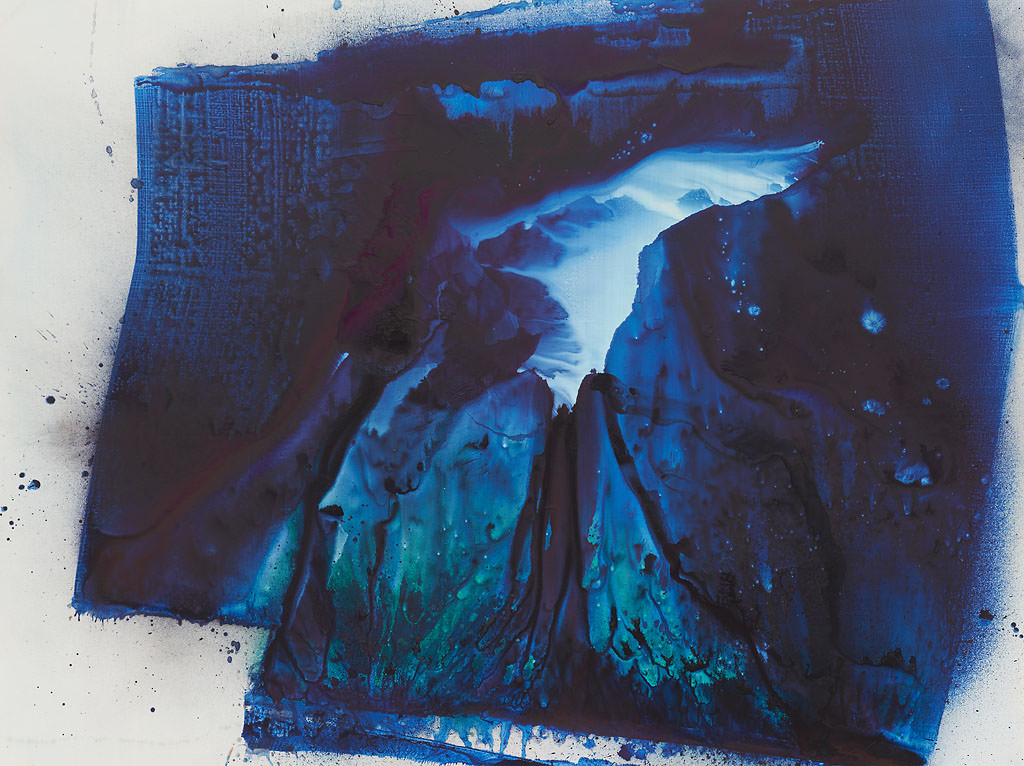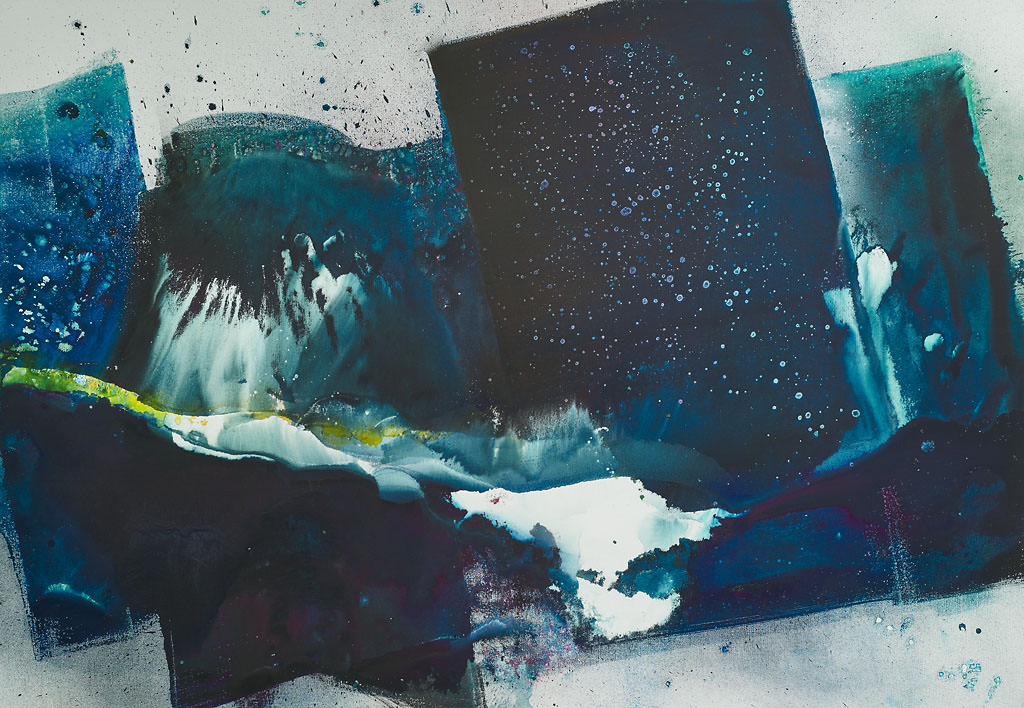MAX FRINTROP „Frontron“
3. September – 5. Oktober, 2016
Exhibition Text (English & German version scroll downwards)
Installation Views:
WORK:
Max Frintrop, 2016, „untitled (Pluviophil Henchman)“, ink, pigments, acrylic, 260 x 180 cm
Max Frintrop, 2016, „untitled (A Window To No Woman)“, ink, pigments, acrylic, 260 x 180 cm
Max Frintrop, 2016, „untitled (Kenjataimu)“, ink, pigments, acrylic, 260 x 180 cm
Max Frintrop, 2016, „untitled (Caravan)“, ink, pigments, acrylic, 260 x 180 cm
Max Frintrop, 2016, „untitled (Abaton)“, ink, pigments, acrylic, 280 x 210 cm
Max Frintrop, 2016, „untitled (Affabrous Holophrasm)“, ink, pigments, acrylic, 240 x 180 cm
Max Frintrop, 2016, „untitled (True Unrealities)“, ink, pigments, acrylic, 220 x 170 cm
Max Frintrop, 2016, „untitled (Love Supreme)“, ink, pigments, acrylic, 210 x 280 cm
Max Frintrop, 2016, „untitled (Ein langes Interview mit Dieter Roth)“, ink, pigments, acrylic, 180 x 260 cm
„Ich will malerische Fragen nicht mit Nein beantworten…“
Gute Malerei war und ist immer besser als ihr Konzept. Ich will nicht den guten alten Zeiten hinterherjammern, aber Malerei ohne einen nachhaltigen theoretischen Überbau des eigenen Werkes will man heute keinem Maler mehr empfehlen. Schade, denn Malerei – wenn sie gut ist – ist natürlich immer besser als ihr Konzept. Gute Malerei erkennt man an guter Malerei, ebenso wie man ein gutes Bild daran erkennt, dass es ein gutes Bild ist. „A rose is a rose is a rose“ geht auch mit Malerei. Ein Bild – logisch – ist mehr als eine Idee. Ein Gemälde ist ein Balanceakt zwischen Tun und Denken, zwischen Malen und Sehen, und zwischen etwas zu malen und es sein zu lassen. Max Frintrops Werk wird bestimmt durch das Malen selbst und durch seine langjährige Beschäftigung mit dem und der Ver- feinerung dessen, was man malen kann (und eigentlich malen will). Es gilt, seiner Intuition zu vertrauen auf der Suche nach dem, was einem „liegt“, und dem, was Relevanz hat. Daran immer weiter konsequent zu arbeiten, zu forschen, durch das Malen selbst weiterzukommen, ist das Wesen Max Frintrops und seiner Malerei.
Es erscheint grundsätzlich sinnvoll, etwas zu malen, was man nicht sagen kann –es sagte sich ja sonst leichter. Zu malen, was man denkt, wäre eine Steigerung dessen. Die Königsklasse ist schließlich die Fähigkeit, das zu malen, was man nicht einmal denken kann. Malen als physische und sichtbare Fortsetzung des Ungedachten er- scheint mir eine konsequente Einlösung der Forderung nach dem allgemeingültigen Konzept zur Malerei insgesamt zu sein. Das Ungedachte in Max Frintrops Arbeiten liegt in seiner Veranlagung, das Malen selbst als Denken anzusehen. Mehr kann man nicht verlangen, mehr ist von Malerei nicht zu leisten.
Dies ist das wahre Ziel guter Malerei: das Finden eines bisher ungemalten Bildes, eines schlüssigen, ikonischen, einprägsamen, vieldeutigen, unbeschreiblichen Bildes, eines Bildes, vor dem der Text versagt und an dem der Blick hängen muss. Ein Bild, das sich alleine behauptet und aus der Masse herausragt, ein Bild das seine rechtmäßige Dimension hat und seine Eigengesetzlichkeit ausstrahlt. All dies klingt herkulisch, aber das macht nichts, weil es bei Max Frintrop passiert. Frintrop ist nämlich durchaus „malsportlich“: Wie es sich gehört, „ringt“ der Künstler mit seinem Bild, er sagt, er ringe es sich vom Herzen ab. Reinste Malerei bedarf des reinsten Anspruches; Max Frintrop sucht Farbe, sucht Komposition, damit jedes Werk Persönlichkeit hat. Ein sehr schöner Satz von ihm lautet: „Jedes Werk soll Persönlichkeit haben und von Persönlichkeit kommen.“ Seinen Arbeiten gehen hunderte Skizzen voraus, das Bild muss in seiner bisweilen kargen Knappheit „sitzen“. Frintrop: „Schönheit ist mindestens gut und kann auch super sein. Ober- flächliche Coolness ist mir immer suspekt. Manchmal finde ich sie zwar ganz unterhaltsam, meistens aber eher nicht.“ Die endgültige Arbeit entsteht dann aus einem, dem richtigen Moment.
Womit wir wieder beim Malen als anderer Form des Denkens sind. Frintrops An- spruch verlangt, sich in komplexen und abstrakten Gefühlen denkend in Spannungen zwischen intuitiven Bildfindungen und dem Prozess zu bewegen und sich eben nicht von klar umrissenen Ideen und Begriffen ablenken zu lassen. Seiner Ansicht nach steht die Malerei in einer archaischen Tradition: „Sie ist der an Sisyphos erinnernde Versuch, sich immer noch tiefer in die Welt der Ideen vorzugraben auf der Suche nach so was wie reinem Geist.“
Eine scheinbar aussichtslose Aufgabe, auf die viele Künstler zurzeit mit eleganter Resignation reagieren. Malerische Fragen werden heute oft mit Nein beantwortet. „Ich versuche das Gegenteil. ich bin kein Besserwisser-Maler oder zynischer Maler, der auf Ästhetiken des Gängigen reagiert oder eine Schönheit des Nichtsmalens praktiziert. Ich will malerische Fragen nicht mit Nein beantworten, ich suche nach dem Ja. Der freie Umgang mit Farbe ist für mich der die Malerei bejahendste Ansatz. Er versucht immer mehrere Elemente von Tiefe miteinander zu verbinden und sich auch überlagern zu lassen.“
Dr. Alexander Klar (Direktor Museum Wiesbaden), 2016
Exhibition Text – English
„I do not want to answer painterly questions with No…“
Good painting was and will always be better than its concept. I do not wish to whine about the good old days, but no contemporary painter is advised anymore to create paintings without a strong theoretical superstructure regarding his own work. This is a pity because painting – when it’s really good – is, of course, always better than its concept. Good painting can be recognized by good painting, just like you know a good painting when you see it. “A rose is a rose is a rose” also applies to “painting”.
A picture is – logically – more than an idea. A painting is a balancing act between doing and thinking, between the act of painting and the act of seeing, and between painting something or letting it be. Max Frintrop’s work is determined by the act of painting itself, as well as by his many years of thinking about and refining what one can paint (and actually wants to paint). It’s about trusting his intuition when it comes to the search for what he “cares” about and what he views as relevant. To work on and investigate this consistently, making headway through the act of painting itself – this is what characterizes Max Frintrop, as well as his painting.
In principle, it seems reasonable that you should paint what you cannot say – other- wise it would make more sense to just say it. To paint what you think would be the next step. The pinnacle, finally, is the ability to paint what you cannot even think. Painting as a physical and visible continuation of the “unthought-of” seems to me to be a logical answer to the demand for a universally valid concept of painting in general. The “unthought-of” in Max Frintrop’s works lies in his predisposition to see the act of painting itself as a form of thinking. You cannot expect more than this; painting cannot deliver more than this.
This is the true goal of good painting: The discovery of a hitherto unpainted picture; a coherent, iconic, memorable, ambiguous, indescribable picture; a picture, to which no text can do any justice; a picture that ineluctably catches your eye. A picture that asserts itself all on its own and stands out from the masses; a picture that has its own inherent dimensions and radiates a sense of its own autonomy. All this may sound Herculean – but that doesn’t matter, since it happens with Max Frintrop.
Frintrop is in fact quite athletic when it comes to painting: As should be expected, the artist “wrestles” with his picture; he says himself that he fights to get it off his chest. The purest painting requires the purest claim; Max Frintrop searches for color, searches for a composition, so that each work has its own personality (a great line of his is: “Each work should have its own personality and be borne out of its own personality.”). His works are preceded by hundreds of sketches; the picture has to be “precise” in its at times meagre paucity.
“Beauty is at least good, and can even be super. I am always suspicious of superficial coolness. Sometimes I find it extremely entertaining, but most of the time this is not the case.” The final work then emerges out of the “right moment”.
At which point we once again come to painting as another way of thinking. Frintrop’s standards demand a kind of thinking in complex and abstract emotions, oscillating in fields of tension between intuitive pictorial solutions and the process of painting itself, and not letting himself be distracted by clearly outlined ideas and concepts. In his view, painting is part of an archaic tradition: “It’s an attempt, similar to that of Sisyphus, to delve even deeper into the world of ideas in search of something akin to pure intellect. An ostensibly hopeless task, to which many contemporary artists react with elegant resignation. Today, painterly questions are often answered with no. I try to do the opposite. I am not a know-it-all or cynical painter, who reacts to the aesthetics of the commonplace or who practices a beauty of non-painting. I do not want to answer painterly questions with no; I am in search of the yes. For me, the free use of colors is the most affirmative approach available to painting. It always strives to combine numerous elements of depth with each other and allows them to overlap.” The compositions with broad brushstrokes are a shadow of graphic and constructive elements, which emerge out of his earlier works and leave their marks in his current paintings. The pictorial background has just as much depth as the color effect of the brushstrokes. “I rarely want to achieve something that merely lies flat on the picture plane. Brown and olive tones often have no sense of depth, and this is why I rarely use them. But yes, various color spaces can emerge especially through their interaction with each other, and the change in their effect is very interesting. In the way in which I paint this, however, and how I try to read my paintings myself, I am simply an Abstract Expressionist. It’s about expression and the gesture. And this should ultimately lead to a good picture. One, which you enjoy looking at for its own sake, which has an effect on you, and does not stand for anything else, has no message or whatever.”
What emerges out of this attitude is a closed cosmos of painterly apparitions, the form of which is variable, but is always held together by the artist’s approach to painting. I cannot help but say: It is Max Frintrop’s attitude that gives his pictures coherency.
Dr. Alexander Klar (Director of Museum Wiesbaden), 2016

